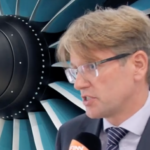GKN Aerospace, which is leading the way with technology developments needed for the future of sustainable aviation, is working to scale up hydrogen-electric propulsion systems to power large aircraft seating nearly 100 passengers, the company’s vice president for technology, Max Brown, has said.
“We initially felt that the smaller aircraft were probably going to be the sweet spot for us, and the team were very focused on 19 seat passenger aircraft,” he explained from Farnborough International Airshow in July.
“But we went through a series of aircraft level and system level architectural studies to understand whether that was optimal. And what we found as our knowledge base grew and some of our technical development was better understood, we suddenly realised that we could actually scale that aircraft concept.”
‘Bigger benefit’
He continued: “So we then looked at 48 seats, and then we even went up to 96 passenger aircraft seating, and to our surprise and to our excitement, we realised that with some of the technologies that we’re now developing we now believe that we can actually scale the hydrogen-electric propulsion system into those larger aircraft and therefore have a bigger benefit on trying to achieve the net zero ambitions that as an industry, we really need to all be heavily focused on.”
At the airshow, GKN announced that its H2GEAR programme had passed a major milestone by completing its first round of system level trade studies.
The studies focused on propulsion system architecture and subsystem technology selection for those hypothetical 19, 48 and 96 passenger concept aircraft.
H2GEAR programme
The H2GEAR programme was launched in 2020 to develop scalable hydrogen electric propulsion technology for a new generation of sustainable aircraft.
The proposed system generates electrical power from hydrogen using fuel cells.
This electrical power is distributed to electric motors which are sized to drive low pressure-ratio ducted fans.
This approach eliminates CO2 and NOx emissions, provides opportunities for contrails mitigation, and is also expected to offer noise reduction opportunities relative to conventional propulsion systems.
Subscribe to the FINN weekly newsletter

